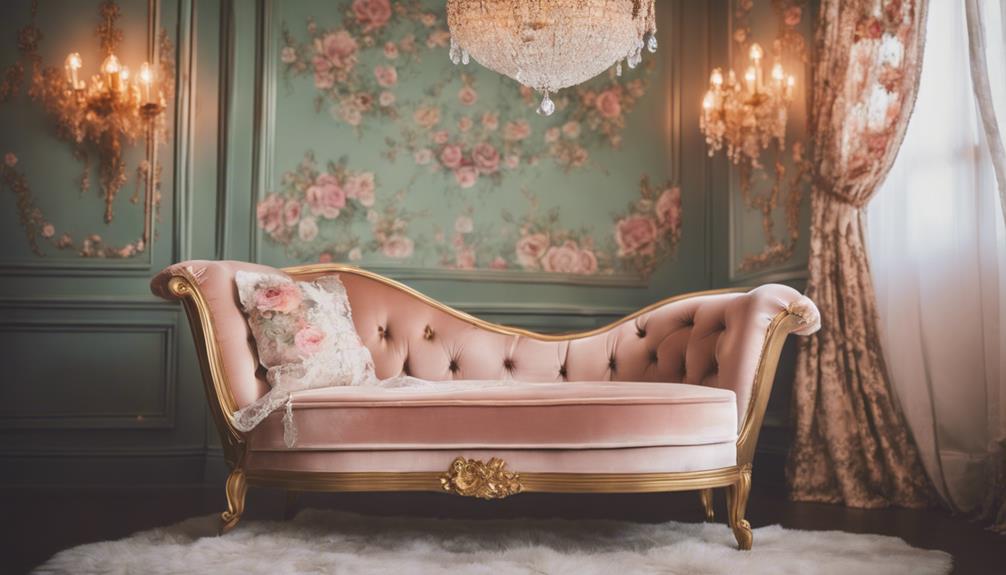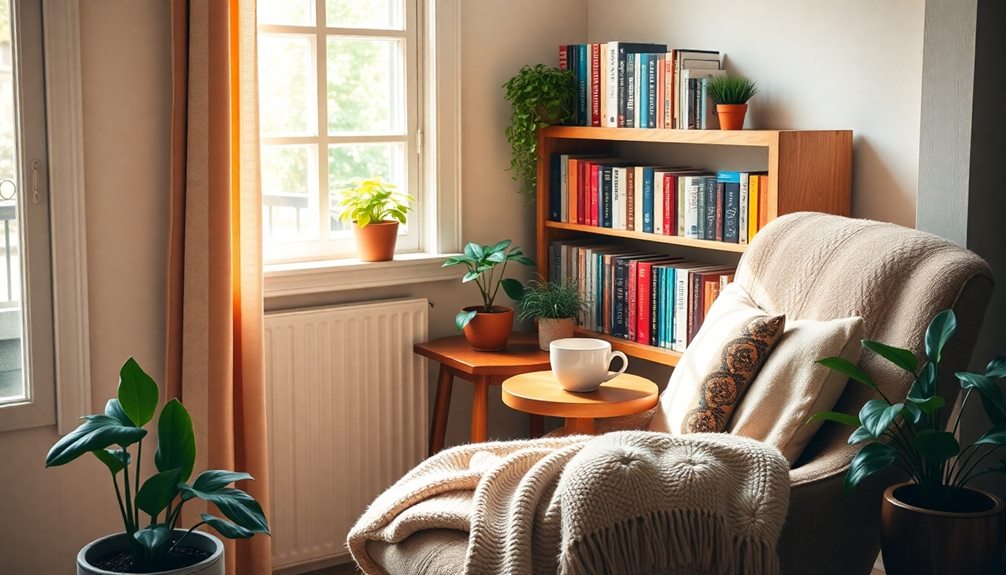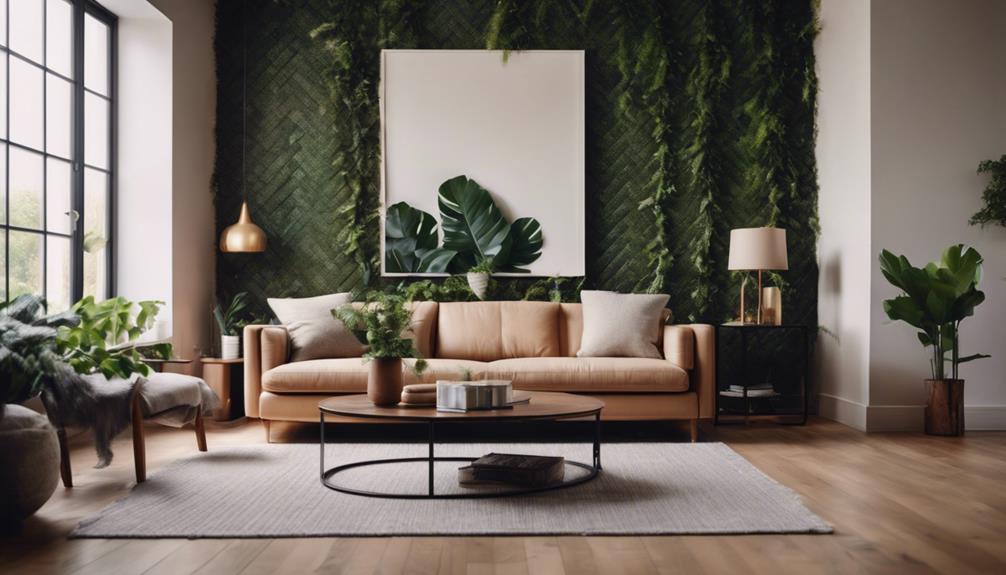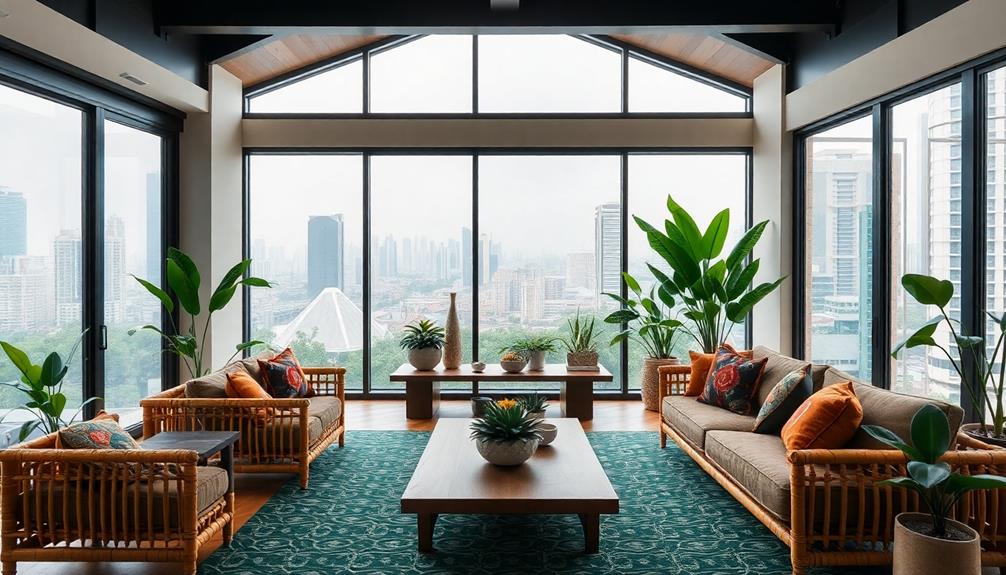Coquette room decor creates a chic and romantic atmosphere that's just perfect for you. Start with soft pastel hues and neutral tones to set a dreamy vibe. Incorporate vintage furnishings, like an ornate vanity and elegant accent chairs, to enhance the charm. Light the space with vintage-style lamps and whimsical string lights for warmth. Don't forget textured elements like lace-trimmed pillows and floral wall art that add depth and character. Embrace flooring options like a soft pink area rug for comfort. Explore more ideas to elevate your coquette aesthetic and make your space truly magical!
Key Elements

To truly capture the Coquette aesthetic, you'll want to focus on the right color scheme, materials, and textures.
Soft pastels and floral patterns help set the mood, while delicate fabrics and unique finishes add depth to your decor.
Color Scheme
The Coquette color scheme embraces soft pastel hues and earthy tones, creating a romantic and playful atmosphere that invites personal expression. Your color palette should focus on neutral shades like white, pastel pink, and cream soda green, which serve as the foundation for your decor. These colors ground your room's design, making it cohesive and inviting.
Layering textures and combining patterns within this palette allows you to showcase your creativity. Don't be afraid to experiment with different shades; incorporating variations in color intensity can enhance the space dramatically. Lighter shades can create a dreamy ambiance, perfect for a relaxed vibe, while deeper tones add contrast and sophistication.
As you curate your color scheme, think about how the pastel and earthy tones evoke a flirtatious nature, aligning perfectly with the Coquette aesthetic. By thoughtfully choosing your colors, you'll establish a charming and chic environment that reflects your personality.
Materials
Soft materials like lace and floral fabrics are key to achieving the Coquette aesthetic, adding a touch of femininity and delicacy to your room decor. When you choose these fabrics, you create inviting aesthetic vibes that resonate throughout your space. Consider incorporating crochet elements and vintage fabrics to enhance the romantic feel.
Vintage elements also play a significant role in this aesthetic. Think ornate picture frames and crystal candle holders to infuse a playful charm into your decor. Tufted upholstery can add that cozy touch while maintaining a chic appearance.
Natural materials like wood and glass should be on your list as well, particularly in furniture and decorative items. They help maintain the soft and warm vibe characteristic of the Coquette style.
Don't forget decorative pieces like vintage mirrors and floral-patterned throw pillows; they not only serve functional purposes but also enhance the overall aesthetic appeal of your room.
Textures
Textures are essential in achieving the Coquette aesthetic, with layers adding depth and visual intrigue to your decor. To create that romantic vibe, incorporate soft fabrics like lace, chiffon, and velvet in your curtains, bedding, and cushions. These materials not only feel luxurious but also exude femininity, making them perfect for your chic space.
Don't shy away from adding crochet elements, such as decorative bed skirts and throws. These vintage touches enhance the tactile experience, giving your room a cozy, inviting atmosphere. Mixing patterns is another great way to elevate your decor. Consider pairing floral prints with polka dots or stripes to create a dynamic and playful look that embodies the Coquette style.
To tie everything together, use textured accessories like fringed lampshades and tufted upholstery. These elements contribute to the overall warmth and charm of the room, ensuring it feels cohesive. By thoughtfully layering textures, you'll transform your space into a stylish retreat that perfectly captures the essence of the Coquette aesthetic.
Essential Fixtures and Furniture

When designing your coquette room, essential fixtures like a vintage vanity table and an elegant dressing table mirror can truly elevate the space.
A chic accent chair not only adds comfort but also enhances the overall aesthetic.
These pieces create a charming and functional environment where you can embrace your style.
Vintage Vanity Table
A vintage vanity table serves as the centerpiece of Coquette decor, showcasing ornate designs and a matching mirror that amplify the room's feminine charm. This essential fixture often features intricate carvings and a distressed wood finish, embodying a charming vintage appeal that perfectly complements pastel color palettes.
When selecting your vintage vanity table, look for one with built-in drawers or shelves. These practical storage solutions help you keep your cosmetics and accessories organized while maintaining a clutter-free appearance. To elevate the vanity setup, incorporate elegant candle holders and decorative trays to display your beauty products stylishly.
Don't forget the seating! A plush stool or chair that aligns with your overall aesthetic adds comfort and completes the look. Additionally, vintage-inspired lighting, like a crystal chandelier or delicate fairy lights, enhances the dreamy ambiance of your space, making your vanity area feel inviting and glamorous.
Chic Accent Chair
Chic accent chairs, like a floral vintage chair or a tufted armchair, instantly enhance the feminine charm of your Coquette-themed room. These stylish pieces serve as focal points, drawing attention and elevating your space's aesthetic. To align with the Coquette color palette, look for chairs in soft pastels or intricate patterns that embody vintage charm and romantic vibes.
When selecting a chic accent chair, consider materials like velvet or lace. These fabrics not only create a luxurious feel but also complement other decor items in your room, such as bedding and wall decor. An accent chair can provide practical seating while adding decorative flair, making it a versatile addition to your space.
Placing it near a vanity or in a cozy reading nook can enhance the overall ambiance. Don't forget to choose a chair with ornate details, such as carved legs or delicate upholstery, to further contribute to the vintage elegance characteristic of the Coquette aesthetic.
Elegant Dressing Table Mirror
An elegant dressing table mirror is essential for creating a feminine focal point in your Coquette-inspired room, adding both style and functionality. This piece not only serves as a practical tool for your beauty routine but also enhances the overall aesthetic with its vintage or ornate design.
To amplify that hyper-feminine vibe, look for mirrors framed with decorative elements like gold or floral motifs. You might want to contemplate a vanity mirror with integrated lighting. This feature is perfect for makeup application and provides a glamorous touch that aligns perfectly with coquette style. If you're feeling particularly romantic, a heart-shaped or tufted mirror design can complement the chic atmosphere of your space beautifully.
Don't forget the importance of placement. Position your elegant dressing table mirror to reflect natural light; this will create a brighter, airier feel and enhance the dreamy ambiance characteristic of the Coquette aesthetic.
With the right mirror, you'll effortlessly elevate your room's charm while enjoying a functional piece that reflects your unique style.
Lighting Ideas

When it comes to lighting in your Coquette room, you'll want to create a soft and inviting atmosphere.
Consider adding a chic chandelier with crystals or soft pink table lamps to enhance the feminine vibe.
Don't forget about string fairy lights and vintage-style floor lamps to add that dreamy sparkle throughout your space.
Chic Chandelier With Crystals
A stunning crystal chandelier captures attention in a coquette room, instantly elevating the space with elegance and a hint of luxury. This chic chandelier with crystals becomes a focal point, enhancing your decor while creating beautiful reflections and rainbows that dance through the room. When hung at the right height, it adds intimacy without obstructing views, making your space feel inviting.
Consider vintage or delicate designs that embody the coquette aesthetic's emphasis on femininity. The crystals not only provide soft, diffused lighting but also interact beautifully with natural light during the day, creating a warm and enchanting atmosphere.
To elevate your lighting further, think about combining your chandelier with softer options like fairy string lights or wall sconces. This layering of light sources will contribute to a dreamy, romantic vibe that defines a coquette room.
Ultimately, a chic chandelier with crystals doesn't just illuminate your space; it transforms it into a stylish retreat. With the right selection and placement, you'll have a stunning centerpiece that enhances your coquette decor and invites admiration from all who enter.
Soft Pink Table Lamps
Soft pink table lamps add a warm, romantic glow that beautifully enhances the feminine vibe of your coquette room. These lamps perfectly complement the Coquette aesthetic, creating an inviting atmosphere that encourages relaxation and comfort.
When selecting soft pink table lamps, look for vintage-inspired designs, such as porcelain bases or delicate glass shades, to align with the overall vintage flair of your decor. Incorporating lamps with intricate details like lace, fringe, or floral patterns can further elevate the whimsical charm of your space.
Dimmable soft pink table lamps are especially versatile; they allow you to adjust the lighting to create a cozy ambiance for evening relaxation or a bright setting for daytime activities.
To establish a cohesive color palette, pair these soft pink table lamps with pastel or neutral-toned decor elements. This combination not only enhances the beauty of the lamps but also embodies the essence of the Coquette aesthetic.
String Fairy Lights
Incorporating string fairy lights into your coquette room decor enhances the romantic ambiance created by soft pink table lamps, adding a whimsical glow that captures the essence of this charming aesthetic.
These lights are a popular choice, effortlessly creating a warm, inviting atmosphere that complements your soft pastel and neutral color palette.
You can drape string fairy lights along walls, wrap them around mirrors, or hang them from the ceiling for a playful touch. Opt for soft white or pastel-colored lights to seamlessly blend with the coquette theme.
If you want a more personalized vibe, consider heart-shaped or vintage-style string lights that resonate beautifully with the feminine elements of the aesthetic.
To elevate your lighting game, pair string fairy lights with wall-mounted candle holders. This layered lighting effect not only enhances the visual appeal of your space but also adds an extra layer of charm.
Vintage-style Floor Lamps
Vintage-style floor lamps transform your coquette room decor with their elegant designs and warm, inviting glow. These lamps often feature ornate materials like brass or glass, adding a sophisticated touch that enhances your space's romantic atmosphere.
When selecting vintage-style floor lamps, look for options with soft pastel shades or floral patterns that harmonize beautifully with your overall color palette. Intricate details, such as fringed or scalloped lampshades, can make your lamp a statement piece, elevating the feminine vibe of the room.
Additionally, incorporating adjustable lamps gives you the flexibility for both functional lighting and ambient illumination, perfect for creating that dreamy aesthetic you desire. Don't overlook lamps with crystal or beaded accents, as they create beautiful reflections and enchanting rainbows of light throughout your space.
These whimsical touches can truly elevate your decor, making every corner feel special. By thoughtfully choosing vintage-style floor lamps, you'll not only enhance the visual appeal of your coquette room but also create a warm, inviting atmosphere that invites relaxation and creativity.
Decorative Elements

To truly capture the Coquette aesthetic, you'll want to focus on decorative elements that embody charm and sophistication.
Delicate floral wall art, vintage porcelain figurines, and lace-trimmed throw pillows can transform your space into a romantic haven.
These touches not only add visual interest but also enhance the overall cozy and feminine vibe you're aiming for.
Delicate Floral Wall Art
Delicate floral wall art, like watercolor paintings or botanical prints, brings a soft, feminine touch that beautifully enhances the Coquette aesthetic in your room. To truly embrace this style, consider incorporating vintage-style frames around your floral art. These frames add charm and nostalgia, making your decor feel more cohesive and inviting.
You can create a visually engaging focal point by hanging your delicate floral wall art in groups or collages. This approach allows for personal creativity in arrangement, letting you curate a unique display that reflects your personality. Alternatively, think about using floral wallpaper with dainty patterns as a backdrop. It instantly infuses your space with a romantic and whimsical vibe.
If you're looking for a low-maintenance option, artificial floral wall decor—such as hanging arrangements or wreaths—can maintain that fresh aesthetic without the worry of wilting. These options allow you to enjoy the beauty of flowers year-round while fitting seamlessly into your Coquette-themed room. By thoughtfully selecting and arranging delicate floral wall art, you'll craft a space that feels both chic and enchanting.
Vintage Porcelain Figurines
Incorporating vintage porcelain figurines into your decor adds a charming touch that complements the soft elegance of delicate floral wall art.
These exquisite pieces often depict delicate scenes or characters, enhancing your space with their intricate details and nostalgic appeal. You can strategically place vintage porcelain figurines on vanity desks, shelves, or side tables to infuse your room with a touch of elegance and femininity.
Characterized by soft pastel colors, these figurines align perfectly with the Coquette color palette of pinks, creams, and other gentle hues.
When displayed thoughtfully, they can reflect your personal story or style, allowing for unique expression in your decor. Consider showcasing your vintage porcelain figurines in ornamental glass cases or pairing them with fresh flowers. This creates eye-catching focal points that elevate the overall ambiance of your room.
Whether you're a dedicated collector or just starting, vintage porcelain figurines can serve as a delightful addition to your Coquette aesthetic.
With their timeless charm, they'll help you create a romanticized living space that feels both chic and inviting.
Lace-Trimmed Throw Pillows
Lace-trimmed throw pillows instantly elevate your Coquette decor, adding a romantic and feminine touch to any space. These decorative elements bring a delicate charm that enhances the overall femininity of your room. Often adorned with soft pastel colors or floral patterns, lace-trimmed throw pillows are perfect for layering with various textures, creating a cozy atmosphere.
Incorporating these pillows introduces a vintage flair reminiscent of the 1950s and 1960s, aligning beautifully with the nostalgic aspects of the Coquette style. They not only serve as stunning accents but also provide comfort and coziness, making your space feel dreamy and inviting. You can mix and match different lace designs to reflect your personal taste while staying true to the Coquette theme.
Experiment with pillow sizes and arrangements to find the perfect combination that enhances your decor. Whether you place them on a vintage-inspired sofa or a plush armchair, lace-trimmed throw pillows will undeniably enhance your chic space. Embrace the charm of these lovely pillows, and watch how they transform your room into a haven of elegance and romance.
Flooring

When it comes to flooring in your coquette-inspired room, you'll want to create a cozy and inviting atmosphere.
A soft pink area rug can add warmth, while whitewashed hardwood floorboards provide a neutral backdrop.
If you're feeling adventurous, consider floral-patterned carpet tiles to infuse a charming, whimsical touch.
Soft Pink Area Rug
A soft pink area rug instantly transforms your space, adding warmth and a touch of femininity that perfectly embodies the Coquette aesthetic. This plush piece serves as a central focus in your room, enhancing comfort and inviting you to lounge or gather with friends. The gentle pink tones harmonize beautifully with the pastel palette typical of Coquette decor, complementing whites, creams, and floral patterns.
When you layer a soft pink area rug over hardwood or tile flooring, you create a striking contrast that adds depth and visual interest to your decor. This layering not only elevates the aesthetic but also provides a cozy area for relaxation.
Consider choosing a rug with delicate patterns or embellishments to enhance the romantic and playful vibe of your space.
Whitewashed Hardwood Floorboards
Whitewashed hardwood floorboards lay the perfect light and airy foundation for your Coquette-inspired space, enhancing its dreamy atmosphere. These floorboards complement the soft pastel colors typical in Coquette decor, adding a vintage charm that evokes the essence of coastal cottages or classic European homes. This flooring style enhances the overall romantic vibe of your room aesthetic, creating a welcoming environment.
The light finish of whitewashed hardwood not only reflects natural light but also makes your room feel more spacious and inviting. This aligns beautifully with the Coquette aesthetic, which emphasizes a sense of airiness and whimsy. Additionally, whitewashed floors are versatile, allowing you to play with various textures and patterns in your decor. You can layer rugs or incorporate unique decor elements without overwhelming the space.
However, remember that maintaining whitewashed hardwood floorboards requires regular cleaning and occasional refinishing. This upkeep guarantees they continue to look fresh and vibrant, ultimately elevating your Coquette style. By choosing this flooring option, you're setting a charming stage for your chic and curated room.
Floral-Patterned Carpet Tiles
Floral-patterned carpet tiles instantly elevate your Coquette aesthetic, infusing the space with a soft, romantic charm that beautifully complements vintage decor. These tiles come in a variety of pastel colors and floral designs, allowing you to customize your floor to match your room's color palette and overall style.
One of the best things about floral-patterned carpet tiles is their practicality. They're easy to install and replace, making it simple to refresh your space without committing to major renovations. Plus, they create a cozy atmosphere, adding warmth and comfort underfoot, which is perfect for achieving that chic, inviting Coquette vibe.
For a more dynamic look, consider layering your floral-patterned carpet tiles with textured rugs. This technique not only enhances the feminine and whimsical feel of your decor but also adds depth and interest to your flooring.
With these versatile and charming carpet tiles, you can create a delightful foundation for your Coquette-inspired room that feels both stylish and welcoming. Embrace the beauty and practicality of floral-patterned carpet tiles, and transform your space into a chic haven.
Conclusion
To create a chic coquette room, focus on blending soft colors, elegant furniture, and cozy lighting.
Incorporate decorative elements that reflect your personality, like vintage finds or playful art.
Don't forget the flooring—opt for something that ties the whole aesthetic together.
By thoughtfully choosing each element, you'll transform your space into a dreamy haven that exudes charm and style.
Now, go ahead and let your creativity shine in your coquette room!









